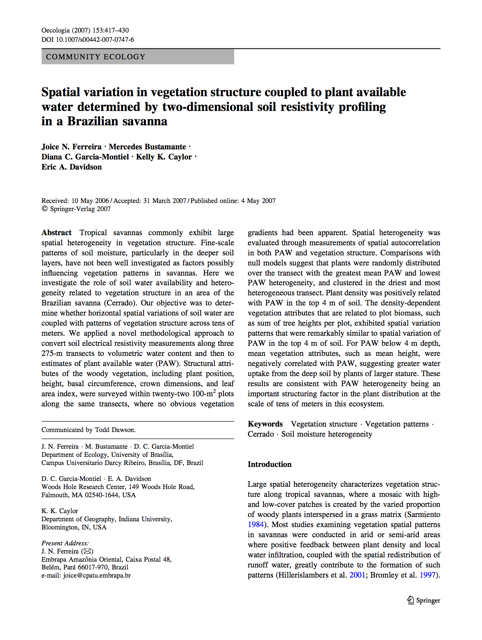Spatial variation in vegetation structure coupled to plant available water at landscape scales in a Brazilian savanna

Ferreira, J.N., M. Bustamante, D.C. Garcia-Montiel, K.K. Caylor, E. A. Davidson (2007) “Spatial variation in vegetation structure coupled to plant available water at landscape scales in a Brazilian savanna,” Oecologia, 153(2):417-430, doi: 10.1007/ s00442-007-0747-6.
Tropical savannas commonly exhibit large spatial heterogeneity in vegetation structure. Fine-scale patterns of soil moisture, particularly in the deeper soil layers, have not been well investigated as factors possibly influencing vegetation patterns in savannas. Here we investigate the role of soil water availability and heterogeneity related to vegetation structure in an area of the Brazilian savanna (Cerrado).
Our objective was to determine whether horizontal spatial variations of soil water are coupled with patterns of vegetation structure across tens of meters. We applied a novel methodological approach to convert soil electrical resistivity measurements along three 275-m transects to volumetric water content and then to estimates of plant available water (PAW). Structural attributes of the woody vegetation, including plant position, height, basal circumference, crown dimensions, and leaf area index, were surveyed within twenty-two 100-m(2) plots along the same transects, where no obvious vegetation gradients had been apparent. Spatial heterogeneity was evaluated through measurements of spatial autocorrelation in both PAW and vegetation structure.
Comparisons with null models suggest that plants were randomly distributed over the transect with the greatest mean PAW and lowest PAW heterogeneity, and clustered in the driest and most heterogeneous transect. Plant density was positively related with PAW in the top 4 m of soil. The density-dependent vegetation attributes that are related to plot biomass, such as sum of tree heights per plot, exhibited spatial variation patterns that were remarkably similar to spatial variation of PAW in the top 4 m of soil. For PAW below 4 m depth, mean vegetation attributes, such as mean height, were negatively correlated with PAW, suggesting greater water uptake from the deep soil by plants of larger stature. These results are consistent with PAW heterogeneity being an important structuring factor in the plant distribution at the scale of tens of meters in this ecosystem.
